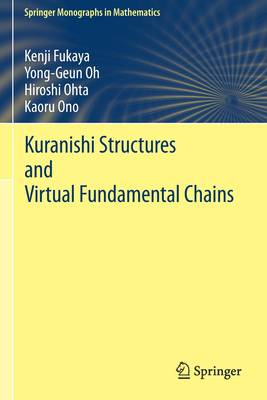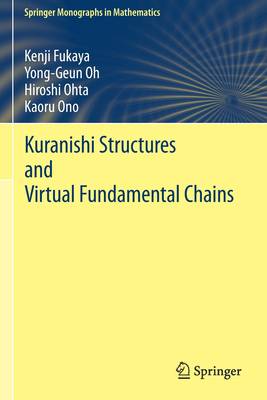
- Retrait gratuit dans votre magasin Club
- 7.000.000 titres dans notre catalogue
- Payer en toute sécurité
- Toujours un magasin près de chez vous
- Retrait gratuit dans votre magasin Club
- 7.000.0000 titres dans notre catalogue
- Payer en toute sécurité
- Toujours un magasin près de chez vous
Kuranishi Structures and Virtual Fundamental Chains
Kenji Fukaya, Yong-Geun Oh, Hiroshi Ohta, Kaoru Ono
213,95 €
+ 427 points
Description
The package of Gromov's pseudo-holomorphic curves is a major tool in global symplectic geometry and its applications, including mirror symmetry and Hamiltonian dynamics. The Kuranishi structure was introduced by two of the authors of the present volume in the mid-1990s to apply this machinery on general symplectic manifolds without assuming any specific restrictions. It was further amplified by this book's authors in their monograph Lagrangian Intersection Floer Theory and in many other publications of theirs and others. Answering popular demand, the authors now present the current book, in which they provide a detailed, self-contained explanation of the theory of Kuranishi structures.
Part I discusses the theory on a single space equipped with Kuranishi structure, called a K-space, and its relevant basic package. First, the definition of a K-space and maps to the standard manifold are provided. Definitions are given for fiber products, differential forms, partitions of unity, and the notion of CF-perturbations on the K-space. Then, using CF-perturbations, the authors define the integration on K-space and the push-forward of differential forms, and generalize Stokes' formula and Fubini's theorem in this framework. Also, "virtual fundamental class" is defined, and its cobordism invariance is proved.
Part II discusses the (compatible) system of K-spaces and the process of going from "geometry" to "homological algebra". Thorough explanations of the extension of given perturbations on the boundary to the interior are presented. Also explained is the process of taking the "homotopy limit" needed to handle a system of infinitely many moduli spaces. Having in mind the future application of these chain level constructions beyond those already known, an axiomatic approach is taken by listing the properties of the system of the relevant moduli spaces and then a self-contained account of the construction of the associated algebraic structures is given. This axiomatic approach makes the exposition contained here independent of previously published construction of relevant structures.
Part I discusses the theory on a single space equipped with Kuranishi structure, called a K-space, and its relevant basic package. First, the definition of a K-space and maps to the standard manifold are provided. Definitions are given for fiber products, differential forms, partitions of unity, and the notion of CF-perturbations on the K-space. Then, using CF-perturbations, the authors define the integration on K-space and the push-forward of differential forms, and generalize Stokes' formula and Fubini's theorem in this framework. Also, "virtual fundamental class" is defined, and its cobordism invariance is proved.
Part II discusses the (compatible) system of K-spaces and the process of going from "geometry" to "homological algebra". Thorough explanations of the extension of given perturbations on the boundary to the interior are presented. Also explained is the process of taking the "homotopy limit" needed to handle a system of infinitely many moduli spaces. Having in mind the future application of these chain level constructions beyond those already known, an axiomatic approach is taken by listing the properties of the system of the relevant moduli spaces and then a self-contained account of the construction of the associated algebraic structures is given. This axiomatic approach makes the exposition contained here independent of previously published construction of relevant structures.
Spécifications
Parties prenantes
- Auteur(s) :
- Editeur:
Contenu
- Nombre de pages :
- 638
- Langue:
- Anglais
- Collection :
Caractéristiques
- EAN:
- 9789811555640
- Date de parution :
- 17-10-21
- Format:
- Livre broché
- Format numérique:
- Trade paperback (VS)
- Dimensions :
- 156 mm x 234 mm
- Poids :
- 902 g

Les avis
Nous publions uniquement les avis qui respectent les conditions requises. Consultez nos conditions pour les avis.






